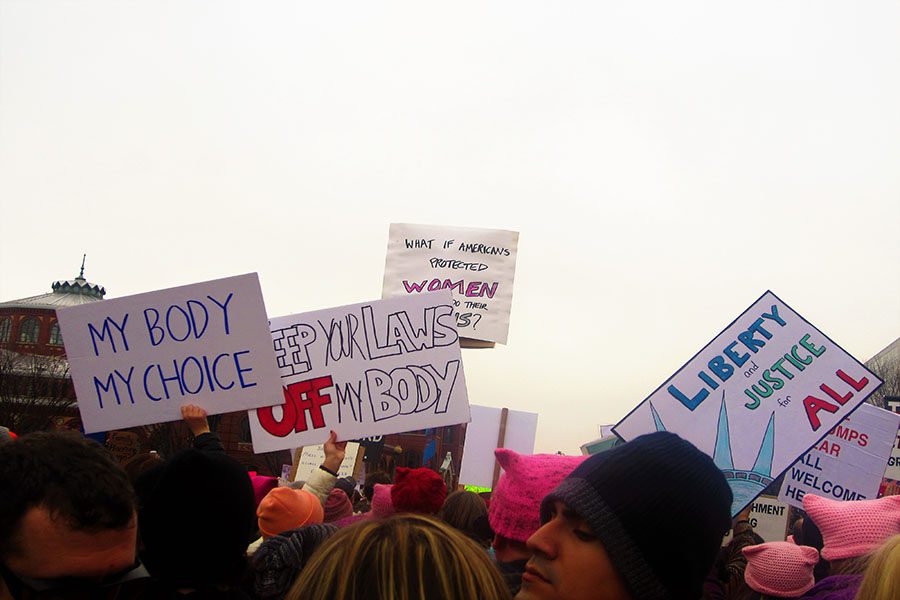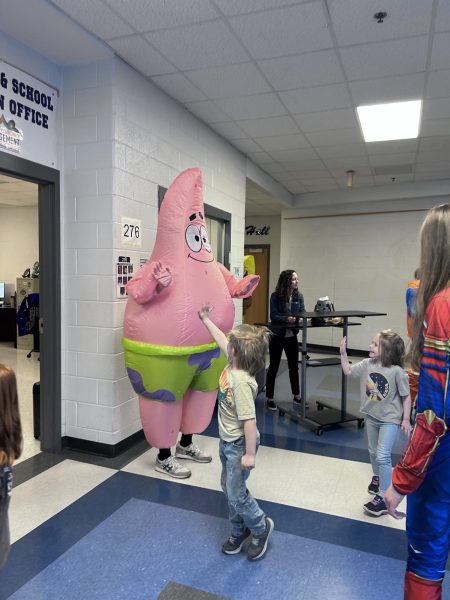Students attend Womens’ March in Washington D.C.
February 9, 2017
On Jan. 21, 2017, only one day after the 45th presidential inauguration, over half a million people rallied in Washington, D.C. in protest of the policies proposed by Donald Trump and his administration. These policies include defunding Planned Parenthood, overturning “Roe v. Wade”, funding a pipeline that will displace indigenous peoples, creating a blanket ban on immigration which specifically targets Muslims and placing a gag order on several federal organizations in order to keep fact from clashing with policy. Due to the widespread outrage, the turnout for the march worldwide capped off somewhere around three million, with protests in all 50 states, more than 70 countries and all seven continents, according to CNN.
In the crowd at the Women’s March on Washington, a number of HHS students made an appearance, including junior Lizet Muniz.
“I went to the march because I’ve been taught to stand up for what I believe in since I was a little girl. I never want to make someone feel lesser because of what they look like or where they come from or what religion they practice,” Muniz said.
For senior Maria Snell-Feikema, the march was more about politics.
“I marched because Trump is a sexist and I wanted to defend my rights by telling him, as well as those others in power, that I deserve equal rights, too,” Snell-Feikema said. “It wasn’t just about women’s rights, though. It was about all the other issues affecting our current political climate, because they affect us not just as women, but as people.”
This mindset was important to a number of protesters, many of whom gathered not only to fight for women’s rights, but for the rights of a number of different of marginalized groups within the US. The protest encompassed the idea that women’s rights are human rights, which meant that it stood for the problems that affected people of every class, color, creed and orientation, not just those of the women in Western civilization.
Junior Julie Hedrick knew a march like this would go down in history.
“I heard about it a few days after Trump was elected, and a few friends of mine who live in NoVa [Northern Virginia] told me I could stay with them and go to the march. I knew I’d have many opportunities to march in the next four years, and I knew this one would be in the history books,” Hedrick said.
For Muniz, the march was about an issue close to her heart.
“My dad was an illegal immigrant,” Muniz said. “When we found out that the march was about more than just women’s rights—that it was about his rights, too—we knew we had to go and show support.”
The march had a permit for around 200,000 people, but due to the ferocity with which the public responded, 500,000 people rallied on Independence Avenue, which congested the streets with people. According to the DC Metro Twitter account, 217,000 people used the Metro before 11:00 on the morning of the march—three times the amount of normal workday commuters.
“We went in on the Metro, but we had to pass three different Metro stations because none of them had parking,” Snell-Feikema said. “When we finally found one with parking, the line wrapped all the way around the building and into a nearby neighborhood.”
Hedrick had a similar experience.
“When we got off the Metro, it wasn’t even close to the beginning of the march. So many people had gathered that the crowd backed up down Independence Avenue to the Metro exit. The march itself was so full of people that it couldn’t even follow the original route. We had to split in half to get to the White House.” Hedrick said.
For some, these kinds of protests are commonplace, but due to the unprecedented turnout for the Women’s March, not only in the U.S., but around the world, many were surprised.
“It was way bigger than most of the other marches I’ve been to,” Snell-Feikema said. “The only other one that was comparable was the People’s Climate March that I went to in New York my sophomore year. [The Women’s March] also seemed to have a lot more people that don’t normally seem like they’d march—it was a lot of upper middle class people who previously have been content with Obama’s policies.”
For Hedrick, the march was a new experience entirely.
“It was a lot more crowded than I thought it would be. I was expecting a lot of people, but not that many,” Hedrick said.
Senior Emma Nouri was touched by the turnout.
“I expected there to be a lot of people, but being there in person and seeing how full the streets were was very different than I had thought it would be. It was empowering to be around so many people that shared my viewpoints and cared so deeply about issues that are important to me. There were so many people that were willing to voice their opinions about the injustices facing us as a country,” Nouri said.
The number of youth rallying at a march like this bodes well for the 2020 election, where current high schoolers will have the opportunity to exercise their vote like they may not have been able to before. Many have high hopes for President Trump’s response, although as of now no formal statement has been made.
“I would like [Trump] to actually respond, and not just act like it didn’t happen. I think he’s really good at listening to his supporters, and he needs to start doing that for the whole of the country because that’s what presidents are supposed to do.” Snell-Feikema said.
For Muniz, it’s more about public activism than Trump’s politics.
“We need to find a happy medium for everyone. No one will ever have the same beliefs, but we need to find a way to accommodate for everyone,” Muniz said. “I want [Trump] to not think that it’s all about him. He’s marginalizing more than half of our nation, and his policies affect more than the rich and white citizens. We need to be heard.”
Nouri feels similarly, but believes that Trump needs to listen.
“[Trump] still hasn’t responded aside from one tweet, and he needs to find a way to do that. The fact that [the march] was not just in Washington, but all over the world, shows a lot about the state of America and the rest of the world. He doesn’t seem to understand that this is bigger than just him. He needs to realize that the protesters aren’t just going to stop protesting; he and his cabinet need to take into consideration all of our feelings and try to do something about it,” Nouri said.
Hedrick also feels that Trump needs to take public opinion into consideration.
“I want [Trump] to know that he needs to take women and our rights seriously. We made America—a woman made Trump—and he doesn’t get to ignore us,” Hedrick said.
The next step for many in regards to the well-being of the nation is more peaceful protest. As of early February, several other marches have been scheduled in favor of the sciences, climate change and LGBTQ rights.
“A lot of the speakers talked about different ways to further our activism, and it would be very wise for the majority of our nation to participate by calling our legislators and writing letters. We need to let them know it’s not just a small number of people–all of us are affected,” Nouri said.
Snell-Feikema feels that protest is the key to making progress.
“We need to protest more, and not give up and just accept Trump’s presidency. That’s not how democracy works. Other countries get so much done because their people get angry about things and they speak out. If we don’t do that, we’re letting oppression win, and that’s not what democracy is about,” Snell-Feikema said.










